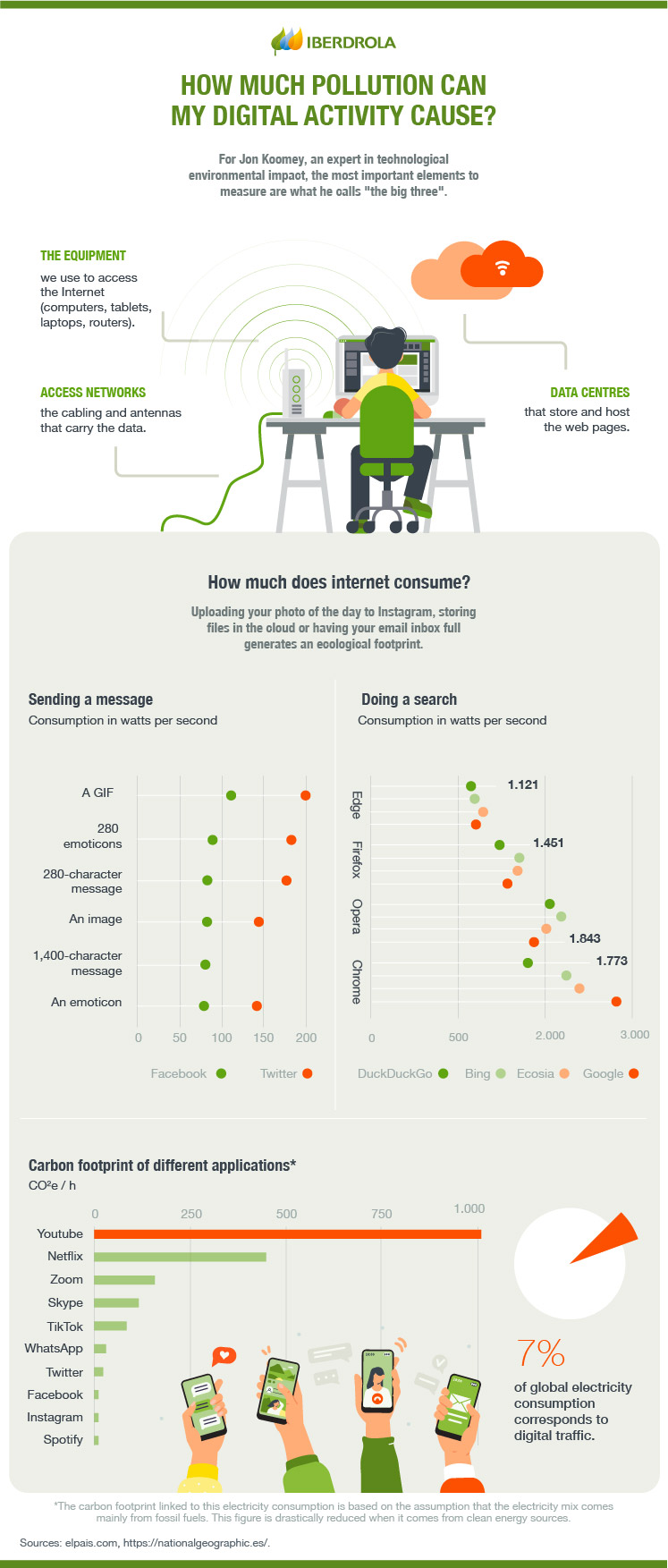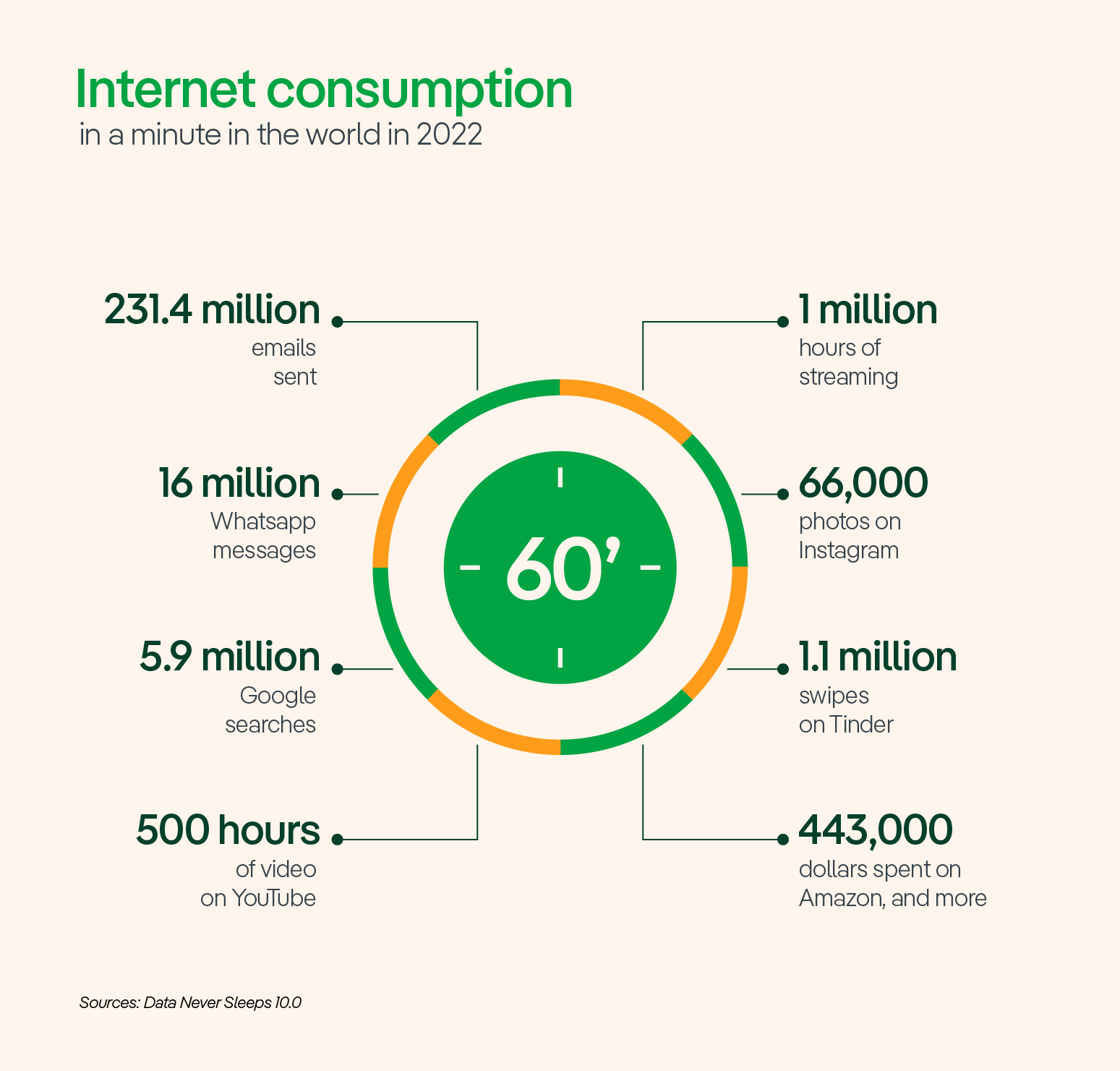Digital sustainability
Digital sustainability as a solution to reduce our environmental impact
Every video and photo we upload to social networks, every document we store in the cloud or every message we send. Digital pollution seems invisible and is silent, but it is no less real. With the advent of 5G and the growing fight against climate change, the concept of 'digital sustainability' is taking centre stage. However, measuring the combined carbon footprint of technology manufacturers, infrastructure and data centres, and billions of internet users is not easy.

Today we can say that there is a consensus on digital transformation as one of the key pathways to a more sustainable economy and society. Digitalisation, according to the World Economic Forum, can contribute to decarbonising the planet by reducing carbon dioxide emissions by up to 35% in the next decade.
The Internet, data-driven technology and its applications in different industries and everyday activities are key to more efficient processes, more immediate and personalised services and, ultimately, a more comfortable life. However, although digital tools provide solutions with an apparently lower demand for natural resources than their analogue versions, they are not always harmless to the planet.
Digital pollution is a growing problem, linked to a great extent to the IT sector's electricity consumption accounting for approximately 7% of global consumption with the European Union forecsting that it will reach 13% by 2030.Hence the urgent need for the transition of this sector to clean energy. According to experts, the share of global CO2 emissions from digital technologies increased from 2.5 to 3.7 % between 2013 and 2018. That means more emissions and a greater impact on global warming than the entire aviation industry, reaching more than 1,6 billion tonnes per year and with forecasts according to Mozilla's Internet Healty Report of being the equivalent of the fourth most polluting country on the planet. This is why we need to talk about the need to achieve digital sustainability.
What is digital pollution?
Digital pollution is the carbon emissions behind our digital activity: From the consumption of data centres to transmission networks to the devices we hold in our hands for hours every day. Global internet use is estimated to consume 416.2 TWh per year - according to a study by Website Carbon - an electricity consumption greater than that of the entire UK.
Each of the hundreds of actions we perform daily on the internet, spontaneously and almost without being aware of them, has a specific carbon footprint. Imagining that the energy mix that reaches our home is composed mostly of fossil fuels such as carbon, each search we do on Google, for example, emits between 0.2 and 1.45 grams of carbon dioxide, which would have to be multiplied by an average of 50 search engine queries per day. Each visit to a website would emit 1.76 grams, which amounts to 211 kilos of CO2 per year for a website with an average of 10,000 visits per month.
Under these same conditions, each email stored on the computer generates around 10 grams of CO2 per year. There is a significant difference between a standard email, which emits about 4 grams of greenhouse gases, and an email with attachments, which can be as much as 50 grams. Furthermore, watching 30 minutes of video on YouTube emits approximately 3 grams of CO2 and streaming a one-hour programme on Netflix would release 56 to 114 grams of CO2.
The advent of artificial intelligence has further increased the computational power required to perform searches, resulting in higher energy consumption. In addition, this will also force an increase in the size of data centres due to the fact that the computation per search is higher than it is today. This results in higher energy costs and more pollution.

SEE INFOGRAPHIC: How much pollution can my digital activity cause? [PDF]
How can digital pollution be reduced?
For Jon Koomey, an expert in technological environmental impact, the most important elements to measure are what he calls "the big three": the manufacture of the equipment we use to access the internet, such as computers, tablets, laptops, routers; the data centres, which store and host the web pages; and the access networks, wiring and antennas that carry the data.
-
Technology manufacturers
Technology companies must manufacture and ship internet hardware internationally, including computers, tablets, smartphones and smart TVs (along with a growing number of smart connected devices) and servers. Manufacturers have a very important role to play in positioning themselves to develop technology that is ethical, socially and environmentally responsible, repairable and has a longer lifespan.
-
Data centres
After devices, data centres are the largest consumers of electricity, with a huge energy demand to provide 24 hours a day, 365 days a year coverage across the globe. To this day, most of these data centres are located in Asia, the Pacific and North America and work with companies that generate a large part of electricity from coal plants. Therein lies one of the main potentials for change towards digital sustainability: the energy transition of these centralised facilities to radically reduce their carbon footprint.
This is the case of Kolos, the new green data centre to be built in Norway, in the town of Ballangen. The aim behind this project is to be the first data centre in the world to supply 100% of its demand with renewable energy. The option of sending data centres to locations where energy can be better utilised has even been considered.
The most curious project is that of the European Commission, whose ultimate goal is to move data centres into space, which it is testing through the ASCEND study  External link, opens in new window. (Advanced Space Cloud for European Net Zero Emission and Data Sovereignty). The project involves polluting practically the same, but outside our atmosphere, which would avoid problems in the medium term.
External link, opens in new window. (Advanced Space Cloud for European Net Zero Emission and Data Sovereignty). The project involves polluting practically the same, but outside our atmosphere, which would avoid problems in the medium term.
-
Access networks
An access network is a type of network that connects our system or end terminal to the most immediate router, enabling a route to connect from that terminal to any other distant terminal. Those connections that are no longer made physically - by cable - have a greater energy demand to resolve; thus, they again depend on the type of electricity contracted to reduce its impact.
In addition, at the user level, computers, smartphones and other connected terminals need to be continuously powered and cooled to operate, in this case drawing electricity from the local energy mix which varies completely in emission levels from one region to another and from one energy rate type and retailer to another.

VER INFOGRAFÍA: Internet consumption in a minute in the world in 2022 [PDF]
Need for sustainable technology
The Internet and "the cloud" have revolutionised our lives: the applications we use every day allow us to chat with our friends and family, to better schedule, coordinate and share work with our colleagues, to listen to our favourite music, and to watch movies and series on demand almost anywhere, anytime. This enormous range of possibilities comes at a price, and that is that it takes a lot of energy to power the huge data centres that store the photos, chats or video streaming we use.
Since 2010, organisations such as Greenpeace have been calling on major internet companies to move away from reliance on fossil fuels such as coal and drive the unstoppable growth of our digital lives with renewable energy. Leading IT companies such as the GAFA (Google, Apple, Facebook and Amazon) are already embracing innovation and committing to the goal of 100% renewable energy sources by signing PPA contracts of renewable energy. With Amazon, we have reached an agreement to meet this target by 2025.
Beyond digital infrastructures and their macro figures, individuals can also take action to reduce their digital pollution. As users, we can make sure we are aware of the environmental impact and the level of responsibility and transparency of the companies from which we buy our equipment. It is also important to buy terminals with the right power for their intended use, in order to optimise their energy consumption, as well as to automate good practices such as always switching off equipment when it is not in use.
With regard to email, it is important to consider what and how many emails to send. But above all, it is very important to delete those that are no longer useful or that are not even going to be read. The reason for this is that they take up storage space, which also costs energy, so deleting them helps to save electricity.
As content creators, on the other hand, one of the best ways to reduce our carbon footprint is again ensuring that we obtain our energy from sustainable energy sources. We can also optimise the energy consumption of a website through good design and optimised programming. A site with clean code and a balanced design will not only load faster than a site full of banners, pop-ups, unresized photos and external programs, but it will also require less energy. The Website Carbon collective makes available for free an interesting carbon calculator for comparisons between different web addresses.

What is big data and what is it used for?
Big data analyses data to turn it into information.

What is Artificial Intelligence?
Are we aware of the challenges of Artificial Intelligence?

History of artificial intelligence
Birth, applications and future trends.





